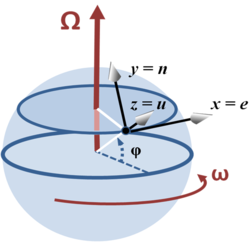< User:John R. BrewsRevision as of 11:54, 5 March 2011 by imported>John R. Brews

(PD) Image: John R. Brews Add image caption here.
Rotating sphere

Figure 2: Coordinate system at latitude φ with
x-axis east,
y-axis north and
z-axis upward (that is, radially outward from center of sphere).
Consider a location with latitude φ on a sphere that is rotating around the north-south axis.[1] A local coordinate system is set up with the x axis horizontally due east, the y axis horizontally due north and the z axis vertically upwards. The rotation vector, velocity of movement and Coriolis acceleration expressed in this local coordinate system (listing components in the order East (e), North (n) and Upward (u)) are:



When considering atmospheric or oceanic dynamics, the vertical velocity is small and the vertical component of the Coriolis acceleration is small compared to gravity. For such cases, only the horizontal (East and North) components matter. The restriction of the above to the horizontal plane is (setting vu=0):


where  is called the Coriolis parameter.
is called the Coriolis parameter.
By setting vn = 0, it can be seen immediately that (for positive φ and ω) a movement due east results in an acceleration due south. Similarly, setting ve = 0, it is seen that a movement due north results in an acceleration due east. In general, observed horizontally, looking along the direction of the movement causing the acceleration, the acceleration always is turned 90° to the right and of the same size regardless of the horizontal orientation. That is:[2][3]
On a merry-go-round in the night
Coriolis was shaken with fright
Despite how he walked
'Twas like he was stalked
By some fiend always pushing him right
—
David Morin, Eric Zaslow, E'beth Haley, John Golden, and Nathan Salwen
As a different case, consider equatorial motion setting φ = 0°. In this case, Ω is parallel to the North or n-axis, and:



Accordingly, an eastward motion (that is, in the same direction as the rotation of the sphere) provides an upward acceleration known as the Eötvös effect, and an upward motion produces an acceleration due west.
Template:Selfref
Notes
http://books.google.com/books?id=-3H5V0LGBOgC&pg=PA122&dq=Foucault+pendulum&hl=en&ei=CV1gTenZOpGisQO9ruzNCA&sa=X&oi=book_result&ct=result&resnum=9&ved=0CGQQ6AEwCA#v=onepage&q=Foucault%20pendulum&f=false
http://books.google.com/books?id=NAo7yv7Jmq0C&pg=PA22&dq=Foucault+pendulum&hl=en&ei=VopgTdmBCoK4sQP6p-ncCA&sa=X&oi=book_result&ct=result&resnum=1&ved=0CCoQ6AEwADgK#v=onepage&q=Foucault%20pendulum&f=false
http://books.google.com/books?id=NAo7yv7Jmq0C&pg=PA22&dq=Foucault+pendulum&hl=en&ei=VYVgTcujHoOusAO0vOXNCA&sa=X&oi=book_result&ct=result&resnum=1&ved=0CCoQ6AEwADgK#v=onepage&q=Foucault%20pendulum&f=false
http://books.google.com/books?id=hrBe52GPHrYC&pg=PA351&dq=Foucault+pendulum&hl=en&ei=VYVgTcujHoOusAO0vOXNCA&sa=X&oi=book_result&ct=result&resnum=9&ved=0CFQQ6AEwCDgK#v=onepage&q=Foucault%20pendulum&f=false
http://books.google.com/books?id=GfCil84YTm4C&pg=PA116&dq=Foucault+pendulum&hl=en&ei=E4ZgTeaDGIa-sQP1zvDHCA&sa=X&oi=book_result&ct=result&resnum=8&ved=0CE0Q6AEwBzgU#v=onepage&q=Foucault%20pendulum&f=false
http://books.google.com/books?id=mms6MXH9CuoC&pg=PA22&dq=Foucault+pendulum&hl=en&ei=34ZgTeukEIuesQPMvPHYCA&sa=X&oi=book_result&ct=result&resnum=2&ved=0CCsQ6AEwATge#v=onepage&q=Foucault%20pendulum&f=false
http://books.google.com/books?id=imrm2aOs9_8C&pg=PA90&dq=Foucault+pendulum&hl=en&ei=34ZgTeukEIuesQPMvPHYCA&sa=X&oi=book_result&ct=result&resnum=7&ved=0CEQQ6AEwBjge#v=onepage&q=Foucault%20pendulum&f=false
Maxwell
http://books.google.com/books?id=wr2QOBqOBakC&pg=PA184&dq=Foucault+pendulum&hl=en&ei=U4hgTd-9Foa6sQP3lt3ACA&sa=X&oi=book_result&ct=result&resnum=2&ved=0CDAQ6AEwATgy#v=onepage&q=Foucault%20pendulum&f=false
Practical matters
http://books.google.com/books?id=sSPLspTUYEEC&pg=PA73&dq=Foucault+pendulum&hl=en&ei=U4hgTd-9Foa6sQP3lt3ACA&sa=X&oi=book_result&ct=result&resnum=4&ved=0CDsQ6AEwAzgy#v=onepage&q=Foucault%20pendulum&f=false
http://books.google.com/books?id=1J2hzvX2Xh8C&pg=PA272&dq=Foucault+pendulum&hl=en&ei=D4lgTdrSGIi6sQPrsunYCA&sa=X&oi=book_result&ct=result&resnum=3&ved=0CDIQ6AEwAjg8#v=onepage&q=Foucault%20pendulum&f=false
References









